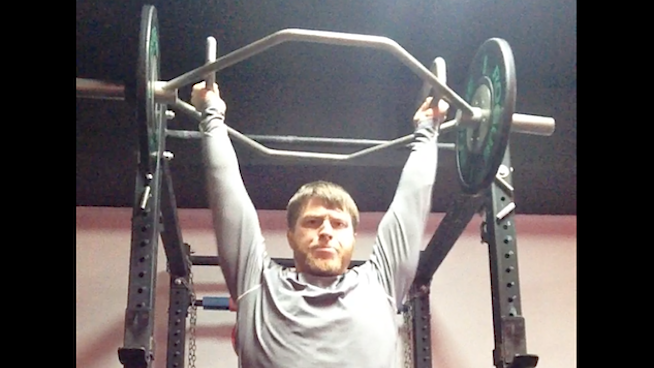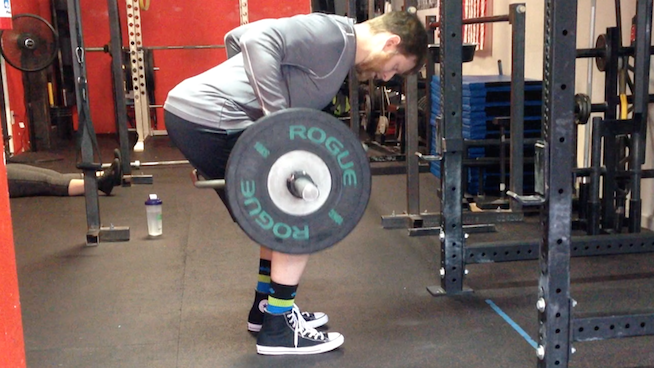Trap Bar Exercises for Upper-Body Gains
![]()
The trap bar (or hex bar) has been touted as an alternative to the straight bar Deadlift for many people. Due to the design of the bar, you grip it bilaterally instead of in front of your body. This changes the line of the pull, providing a safer alternative, especially for people worried about a lower-back injury.
Deadlifting, however, is only one the many varieties of trap bar exercises you can perform.
Using the same load position, you can use the trap bar to add variation to your upper-body movements as well. With a straight bar, you are limited to gripping in a supinated or pronated position; and though this works for many people, others who may have cranky shoulders can benefit from use of a tool that offers a more neutral grip.
Upper-Body Push
With both horizontal and vertical pushing movements, it’s important to grip the handles in the middle to prevent the bar from tipping one way or another. This control is one of the hardest aspects of any of the Trap Bar Pushes.
Trap Bar Bench/Floor Press

Floor pressing with dumbbells offers a certain degree of freedom with your hand and wrist position. However, progressively overloading the muscles to build strength and size can become an issue. Using the trap bar allows you to load and lift more weight, thereby increasing results for your chest, shoulders and triceps.
Setup: Lie either on the floor or on a bench, grip the bar and lower it toward your chest. Avoid hitting yourself in the head as you lower the bar. Once you reach an appropriate range of motion, press the bar up.
Overhead Press

One of the drawbacks to pressing overhead with a traditional barbell is that you might encounter physical obstacles—namely, avoiding hitting yourself in the face with the bar. This trap bar variation places you squarely in the center of the bar, avoiding any potential mishap. As previously mentioned, keeping your hands in a neutral position places your shoulders in a more joint-friendly position.
Setup: Stand in the middle of the bar, grab the handles and press overhead in much the same fashion you would for a normal Overhead Press.
Upper Body Pull
Bent-Over/PendlayRows

With Bent-Over or Pendlay Barbell Rows, the weight is loaded in front of the body, which can place stress on the lower back and lead to hazardous and awkward looking Rows. When you use the trap bar, the weight is loaded bilaterally, which is more optimal for the lower back, much like the Deadlift.
Setup: Stand in the middle of the bar, much like you would for a Deadlift. Hinge at the hips and grab the handles of the trap bar until your upper body is parallel to the ground. Initiate the Row from your upper back and pull toward your hips.
Not only is the trap bar useful for Deadlifts, it’s also a great tool for performing neutral grip presses and pulls to build upper-body strength and promote muscle growth.
READ MORE:
[cf]skyword_tracking_tag[/cf]RECOMMENDED FOR YOU
MOST POPULAR
Trap Bar Exercises for Upper-Body Gains
![]()
The trap bar (or hex bar) has been touted as an alternative to the straight bar Deadlift for many people. Due to the design of the bar, you grip it bilaterally instead of in front of your body. This changes the line of the pull, providing a safer alternative, especially for people worried about a lower-back injury.
Deadlifting, however, is only one the many varieties of trap bar exercises you can perform.
Using the same load position, you can use the trap bar to add variation to your upper-body movements as well. With a straight bar, you are limited to gripping in a supinated or pronated position; and though this works for many people, others who may have cranky shoulders can benefit from use of a tool that offers a more neutral grip.
Upper-Body Push
With both horizontal and vertical pushing movements, it’s important to grip the handles in the middle to prevent the bar from tipping one way or another. This control is one of the hardest aspects of any of the Trap Bar Pushes.
Trap Bar Bench/Floor Press

Floor pressing with dumbbells offers a certain degree of freedom with your hand and wrist position. However, progressively overloading the muscles to build strength and size can become an issue. Using the trap bar allows you to load and lift more weight, thereby increasing results for your chest, shoulders and triceps.
Setup: Lie either on the floor or on a bench, grip the bar and lower it toward your chest. Avoid hitting yourself in the head as you lower the bar. Once you reach an appropriate range of motion, press the bar up.
Overhead Press

One of the drawbacks to pressing overhead with a traditional barbell is that you might encounter physical obstacles—namely, avoiding hitting yourself in the face with the bar. This trap bar variation places you squarely in the center of the bar, avoiding any potential mishap. As previously mentioned, keeping your hands in a neutral position places your shoulders in a more joint-friendly position.
Setup: Stand in the middle of the bar, grab the handles and press overhead in much the same fashion you would for a normal Overhead Press.
Upper Body Pull
Bent-Over/PendlayRows

With Bent-Over or Pendlay Barbell Rows, the weight is loaded in front of the body, which can place stress on the lower back and lead to hazardous and awkward looking Rows. When you use the trap bar, the weight is loaded bilaterally, which is more optimal for the lower back, much like the Deadlift.
Setup: Stand in the middle of the bar, much like you would for a Deadlift. Hinge at the hips and grab the handles of the trap bar until your upper body is parallel to the ground. Initiate the Row from your upper back and pull toward your hips.
Not only is the trap bar useful for Deadlifts, it’s also a great tool for performing neutral grip presses and pulls to build upper-body strength and promote muscle growth.
READ MORE:
[cf]skyword_tracking_tag[/cf]










